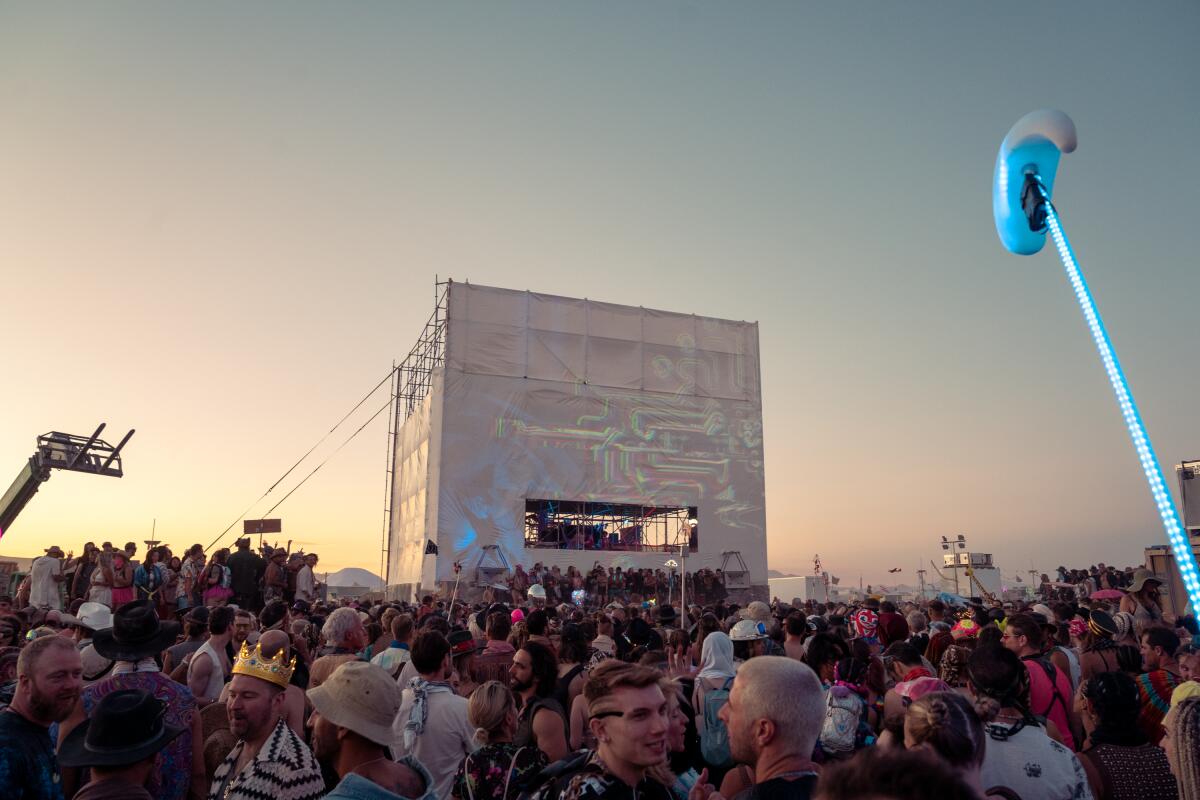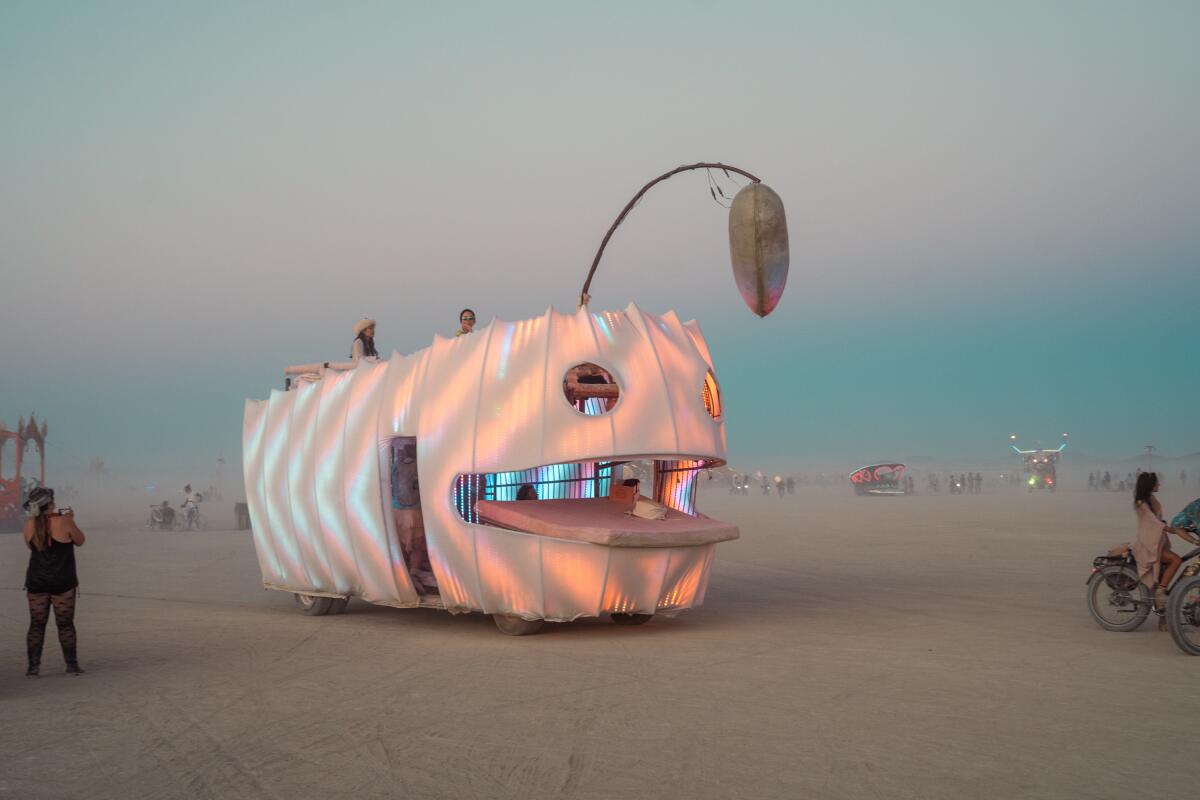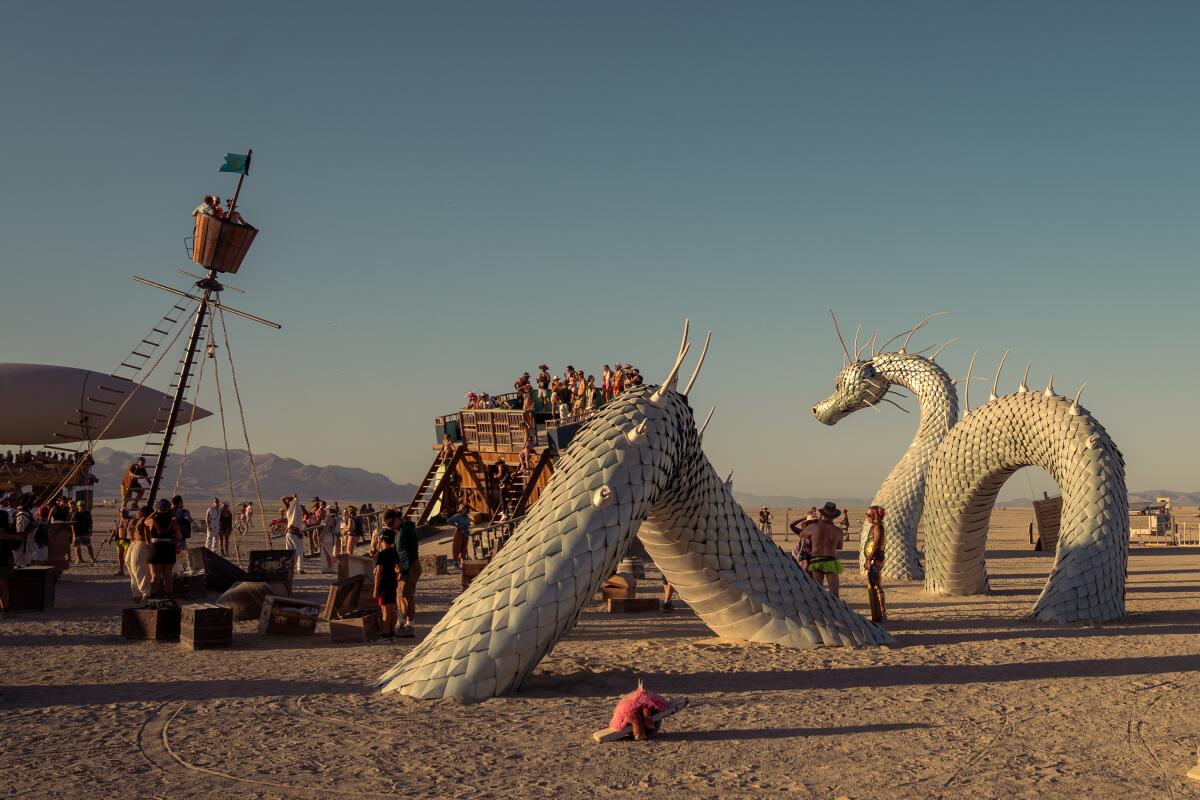Burning Man is a schlep. For the average participant, one must be radically self-reliant and purchase enough food, water and supplies to survive at least seven days in an arid, dusty desert where the only thing for sale is ice. It’s a seemingly endless loop of packing, loading, unloading, unpacking, building and setting up, only to break down, repack, reload, unload and unpack all over again. In between, the body and brain are depleted of fluids and serotonin, while everything you bring collects a layer of corrosive alkaline dust that follows you home.
For those who choose to lead a massive theme camp of over 300 people, you might as well be prepping for the 10-year Trojan War. A common assumption made by those who are unfamiliar with the Burning Man ethos is that the seven square miles of Black Rock City’s elaborate art installations, sculptures, stages, theme camps and art cars are created by a production overlord like Goldenvoice or Insomniac. The reality is that most of Burning Man is dreamt, designed, built and paid for by its scrappy, resourceful attendees — the majority of whom are not backed by tech moguls or millionaires.
Like Burning Man’s humble beginnings on Baker Beach in the 1980s, Frothville began as a small band of “Frothin’ Weirdos” (their original camp moniker) whose claim to fame was their sunrise ribs and champagne party with tunes provided by longtime Burner Random Rab. As the years progressed, so did the Frothin’ Weirdos, who absorbed multiple camps and eventually morphed into Frothville. After a successful conglomeration in 2023, this year’s camp leads — Jesse Albright, Gus Irwin and Zachary Cotler — decided to take on their most ambitious endeavor yet.
Along with a 50-foot wedding venue dome and several back-of-house accouterments, Frothville’s main attraction was a five-story rectangular tower known as “The Gallery,” which was placed on the Esplanade, Burning Man’s busiest thoroughfare. Wrapped in white vinyl, it featured psychedelic projection mapping on its exterior and could be seen from across the playa — a convenient beacon while slashing through the night in a discombobulated state. In addition to hosting musical acts such as Griz, Diplo, Frances Mercier, Maddy O’Neal, Monolink and Random Rab, each level of the tower featured bedecked nooks and crannies in which to dance, lounge, snuggle, dangle and sip. As you ascended the labyrinthine stairs of scaffolding, you’d eventually arrive at the open top level where you’d take in a 360-degree view of Burning Man, which, especially at nighttime, was a visual smorgasbord of swirling lights and nebulous fire.
Many of the camp leads and their support teams had been working on this project for upwards of 40 hours a week across eight months, nearly doubling those hours in the weeks approaching the event that began in late August. With an original budget of $440,000, the actual spend was closer to $650,000, which was raised by us, the campers, as well as donated through the Gallery Foundation, a 501(c)3 that offers year-round support for both up-and-coming and established artists. While the Gallery’s impressive feat of construction garnered oohs and ahhs from visiting revelers, business behind the scenes was fraught.

Frothville’s main attraction, a five-story rectangular tower known as “The Gallery.”
(Miles Najera)
My second year with Frothville was a very different experience from last year — and not just because of the biblical rainfall that smattered headlines. The 2023 iteration was more intimate with a deeper sense of connection and camaraderie among camp mates, despite hosting over 200 people. There was a playfulness and affability that was lacking this year, and was instead replaced by tension, haughtiness, indifference and downright rudeness — a sentiment that I heard from multiple camp mates, both old and new. I made many attempts to help and befriend unfamiliar faces, and was often met with biting disrespect, aloof rejection or condescending remarks. There were several people who did not lift a finger and blew off their work shifts, forcing other campers to step up and keep things running. It was jarring and incongruous, especially because the Burning Man community has long been a source of love, connection and communal effort, particularly within Frothville.
The issues began early on, as rain and wind slowed down production and people who were meant to assist during build week were unable to get early entry passes, stranding them in nearby cities. The tower build continued far past opening day, as attendees appeared expecting performances from artists such as Treavor Moontribe and instead found a construction site — a common occurrence across the playa. Scheduled work shifts were delayed and continually rearranged, causing confusion among campers as to how and when to contribute (also a common occurrence). While some of us found ways to help, others took it as an opportunity to eschew their responsibilities. However, those of us who showed up united, and handled business, did so with aplomb, swigs of liquor, a couple of near-death experiences and gales of laughter. Such is Burning Man.
What was initially viewed as a visionary achievement and epic gift to Black Rock City, soon became a source of contention, where camp leads and builders were often left scowling and defeated. Close to midweek when the tower was finally functional, I caught glimpses of joy and gratification on the faces of those who poured their literal blood, sweat and tears (there were a few minor injuries) into this project. Some of those with whom I’d had negative interactions were all hugs and smiles as the weight of safely building a giant structure on a deadline was lifted from their shoulders. The mission — despite its imperfections, obstacles, and delays — was accomplished, and the thousands of attendees who enjoyed its offerings were none the wiser to its taxing beginnings.
There were many successes — like the extravagant aerialists and fire dances who enlivened our dance floor. A steady stream of top-tier musicians lured people in from all corners of the playa, as friends from other camps were gobsmacked by the sheer size and spectacle, giving no thought to how it was accomplished. Despite the undercurrent of stress that ran through camp, there was much for which to be grateful, plus the brilliant, badass and talented people behind it all who I am lucky to call friends. Again, such is Burning Man.

Free-wheeling DIY structure at Burning Man.
(Miles Najera)
After last year’s muddy debacle, the BRC deities blessed us with a week of idyllic weather offering minimal dust, warm days and cool evenings. But just when we thought we’d skirted yet another meteorological event, a white-out dust storm darkened the once-blue sky on Sunday, Sept. 1 — Burning Man’s last day.
“I felt like it was Mt. Vesuvius spewing out dust and we were going to be buried in ash like Pompeii,” says Victoria Cotler, Zachary’s partner, who celebrated their wedding at our camp’s wedding venue. Not only were conditions so bleak that the flames of the burning temple were dimmed to an eerie pulsating glow, but the disassembly of the tower, along with the wedding dome and other back-of-house structures, was delayed. Exodus became a dangerous trail of taillights flickering through the dust like fading fireflies, and camps across the playa feared they’d be stuck breaking down until the end of the week.
According to Frothville lead Jesse Albright, about 100 people committed to helping with breakdown, and as of Tuesday, Sept. 3, only 15 remained. This skeleton crew worked upwards of 20 hours per day in dangerous blustery conditions to strike camp and fulfill one of Burning Man’s most imperative tenets: “leave no trace.” Disappointed, exhausted, and bedraggled, Albright sent a hail mary to the Frothville WhatsApp thread, entreating us to donate money to hire laborers. While not ideal, it is an understandable plea as they were facing a weeklong delay with dwindling supplies, hands and morale. Soon after his message was sent, the donations started rolling in. For those of us who paid to leave Sunday due to work and other life commitments, it was a way to contribute and ease the guilt of not being in the dust with our struggling strike team.
This is what it takes to build a giant theme camp. Nothing is easy, nothing is fast. One must face disappointment and failure, but also bask in the warmth of hard-fought victories. While Burners are typically of a higher caliber when it comes to civic responsibility and communal effort, they’re still humans, which means error is inescapable — especially when you throw over 60,000 of them into outlandish circumstances. However, where some relationships were tested and ultimately ended, others were strengthened. As of Wednesday, Sept. 4, the tower was fully disassembled and the final tasks of breakdown were within reach. After surviving such an excruciating venture, the question on many people’s minds is, was it worth it? According to Cotler, it was. “Well, we’re masochists aren’t we?” he jokes. “Yes, of course it was worth it and we would do it over and over again because that’s what Burning Man is. The art of a large Burning Man camp is the people who are in it.”

DIY structure at Burning Man.
(Miles Najera)
There’s nothing perfect about Burning Man. There’s manual labor and gallons of sweat involved. Porta-Pottis are an inevitability, not a choice, and the likelihood of injury is high. Plans are sabotaged, schedules are useless, and expectations are a waste of time. You can have a mental breakdown and threaten to leave at sunset then be blissed out on an art car by midnight. You can commit to an overly ambitious project that may have caused conflict, struggle and aggravation, but in retrospect, will be fondly remembered as an epic creation that evoked happiness while overcoming adversity. If you’re able to find joy amid the hardships, you’re doing it right.
“We have to be OK with it not being perfect,” says Victoria. “It’s not about us. We had to shed our egos and realize that we came together to share something beautiful, and that’s enough. No matter what’s going on behind the scenes, we have to go into the world with a smile and be those leaders. Even if this sucked, even if this was stressful, let’s be grateful and happy for the greater good of the community.”


